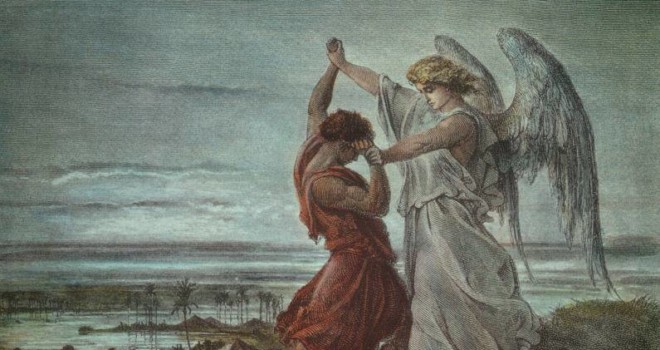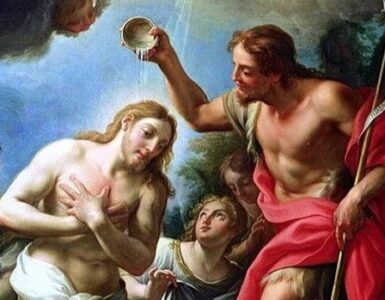Jacob was left there alone. Then a man wrestled with him until the break of dawn.
When the man saw that he could not prevail over him, he struck Jacob’s hip at its socket, so that Jacob’s socket was dislocated as he wrestled with him.
The man then said, ‘Let me go, for it is daybreak.’ But Jacob said, ‘I will not let you go until you bless me.’
‘What is your name?’ the man asked. He answered, ‘Jacob.’
Then the man said, ‘You shall no longer be named Jacob, but Israel, because you have contended with divine and human beings and have prevailed.’
Jacob then asked him, ‘Please tell me your name.’ He answered, ‘Why do you ask for my name?’ With that, he blessed him.”
-Genesis 32:25-30
The day Sarah was born, I learned what it meant to fight the inner battle between my will and God’s.
Since that day, wrestling my dark figures has become commonplace, yet not easier. In fact, it becomes increasingly challenging – because God is calling me to deeper, darker places within myself that I did not before have the courage to face.
Darkness is a strange concept. We hear about it as something to avoid at all costs. As children, we were told frightening tales of what happens in the dark, usually which included the likes of monsters and goblins and all sorts of ghouls. The typical ways we celebrate Halloween also involves all the creepy crawly things that emerge only when it is dark. Demons, too, tend to hide like cockroaches from the daylight.
At the same time, much growth – often the most growth – occurs in darkness. Only in darkness, in fact. The tug and pull between our fear and unraveling what it means to fully trust God is an interior war each of us faces at various intervals throughout our lives: when we wonder if our marriage will survive or fail; when we lost a child to stillbirth or suicide or cancer; when we lose a job and find ourselves in financial ruin.
These dark figures are mysterious blessings, but we cannot see them as such at the time. The dark figure in Genesis is purported to be either an angel or God Himself. Either way, Jacob does not recognize him as a heavenly figure, only as one that wounds him. And the wound he received in his hip socket remained with him – even after the figure did as Jacob requested, and blessed him.
Many mystical saints have boldly proclaimed that God does, in fact, wound us. Again, a paradoxical concept to those of us who have been taught to believe that God’s love only heals and never hurts. But the type of wound that occurs in the soul receptive to it is actually a wound of love. It is a physical and mystical participation in the Wounds of Christ.
All wounds are painful. The love of God, when experienced deeply, profoundly, and constantly is the type of pain that is akin to chest pain or heartache. It is a throbbing so noticeable that the person experiencing it believes, at first, that it is punitive rather than blessed. It hurts that badly.
Why does this mystical wound reveal love? Because a heart that is given the suffering of some, yet gives the excruciating experience of that suffering to Jesus, is a heart that is growing into greater, purer love.
The darkness is not always where evil lurks. Remember that God created the darkness. Even the Psalmist wisely stated, “Darkness is not dark for you, and night shines as the day. Darkness and light are but one” (139: 12). This is because God dwells in the darkness, too. He waits for us to meet Him in our shadows, by confronting the wounds we’d rather conceal, by directly dealing with our grief and sorrow.
I think it’s easier for me to see this now that Sarah is nine years old, and I have been wrestling with my dark figure for many years now. Sometimes I believe it has come to harm me, but when I have some distance between the intense experience of my pain and the balm that the passage of time grants me, I can see its blessing more evidently.
Babies grow in the darkness of their mothers’ wombs. Seeds germinate below the earth in its dark chambers. Caterpillars wait to become winged creatures in the blankets of their cocoons. Jacob’s name was changed to Israel after he chose to demand that the figure bless him, even as it wounded him, and this was symbolic of the transformation that occurs in every conversion and metamorphosis.
When I am in the midst of fighting my dark figures, I tend to wail and sob and beseech God in desperation as if I were a beggar (because I am) to save me, to release me from my anguish, to end this seemingly never-ending torment. I am, in essence, telling my dark figure to bless me. I already know the wound has been inflicted upon me, but it is not a wound meant to maim. It is a wound of thorns that Jesus has offered me as a blessing.
These periods of wrangling the dark figures leave me weary, dry, incapable of formulating any prayer beyond, “Please help me, Lord.” And it seems in the midst of these long nights of the soul that He does not answer. The crosses of my life become insurmountable, even as I surrender them to Jesus over and over.
But then something miraculous happens when I am at the end of what I can bear, sometimes well past what I can bear. A part of me is changed. I might adopt a more compassionate stance on an issue I had previously been closeminded to. I might open my heart or home to someone I used to overlook or judge. I notice a softening of the heart, but at the same time a renewed strength of heart.
It is the coalescence of might and tenderness that happens in me gradually, gently. God never forces our transformations. He only beckons us to become more tomorrow than who we are today. The courage to face what is terrible, hard, and even impossible is precisely what turns our wounds into strange blessings that lead us into the new terrain of what life has in store in the present time. It is the blessed expanse of hope.
My lesson learned from battling the dark figures: New life happens in the darkness. Always.
✠












